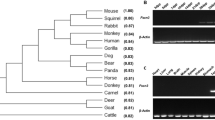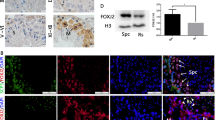Abstract
Background
Skp1-Cullin-F-box (SCF) E3 ligase complex plays an important role in regulating spermatogenesis and fertility in mice. As a member of F-box proteins, the function of F-box and WD-40 domain protein 17 (Fbxw17) during spermatogenesis and fertility is unclear. In this study, we illustrate its function for spermatogenesis and fertility.
Methods and results
Here, we generated the Fbxw17 knockout (KO) mouse model by using the CRISPR/Cas9 system and analyzed the meiotic process and the fertility. Then, our results demonstrated that testis and sperm in the Fbxw17 KO mice had normal morphology. The testis weight, sperm count and fertility of Fbxw17 KO mice showed no significant difference compared with the wild-type mice. Subsequently, histological analysis of Fbxw17 KO mice revealed apparently normal germ cells of all stages and mature spermatozoa. Meanwhile, nuclear spread analysis showed that the synaptonemal complex formation and DSB repair proceeded normally in Fbxw17-deficient spermatocytes. Furthermore, we didn’t find defects in the meiotic prophase I spermatocytes and germ cells showed no apparent apoptosis in Fbxw17 KO mice.
Conclusions
Our results show that Fbxw17 is dispensable for fertility in mice.




Similar content being viewed by others
Data availability
We confirm that the data supporting the findings of this study are available within this article and its supplementary materials.
References
Xie J, Jin Y, Wang G (2019) The role of SCF ubiquitin-ligase complex at the beginning of life. Reprod Biol Endocrinol 17:101
Zheng N, Schulman BA, Song L, Miller JJ, Jeffrey PD, Wang P, Chu C, Koepp DM, Elledge SJ, Pagano M et al (2002) Structure of the Cul1-Rbx1-Skp1-F boxSkp2 SCF ubiquitin ligase complex. Nature 416:703–709
Cardozo T, Pagano M (2004) The SCF ubiquitin ligase: insights into a molecular machine. Nat Rev Mol Cell Biol 5:739–751
Zhou L, Yang Y, Zhang J, Guo X, Bi Y, Li X, Zhang P, Zhang J, Lin M, Zhou Z et al (2013) The role of RING box protein 1 in mouse oocyte meiotic maturation. PLoS ONE 8:e68964
Guan Y, Leu NA, Ma J, Chmatal L, Ruthel G, Bloom JC, Lampson MA, Schimenti JC, Luo M, Wang PJ (2020) SKP1 drives the prophase I to metaphase I transition during male meiosis. Sci Adv 6:eaaz2129
Skaar JR, Pagan JK, Pagano M (2013) Mechanisms and function of substrate recruitment by F-box proteins. Nat Rev Mol Cell Biol 14:369–381
Nguyen KM, Busino L (2020) The biology of F-box proteins: the SCF family of E3 ubiquitin ligases. Adv Exp Med Biol 1217:111–122
Gopinathan L, Szmyd R, Low D, Diril MK, Chang HY, Coppola V, Liu K, Tessarollo L, Guccione E, van Pelt AMM, Kaldis P (2017) Emi2 is essential for mouse spermatogenesis. Cell Rep 20:697–708
Wang W, Wang W, Xu Y, Shi J, Fu J, Chen B, Mu J, Zhang Z, Zhao L, Lin J et al (2021) FBXO43 variants in patients with female infertility characterized by early embryonic arrest. Hum Reprod 36:2392–2402
Wu H, Zhang X, Shen Q, Liu Y, Gao Y, Wang G, Lv M, Hua R, Xu Y, Zhou P et al (2022) A homozygous loss-of-function mutation in FBXO43 causes human non-obstructive azoospermia. Clin Genet 101:55–64
Hua R, Wei H, Liu C, Zhang Y, Liu S, Guo Y, Cui Y, Zhang X, Guo X, Li W, Liu M (2019) FBXO47 regulates telomere-inner nuclear envelope integration by stabilizing TRF2 during meiosis. Nucleic Acids Res 47:11755–11770
Barbosa P, Zhaunova L, Debilio S, Steccanella V, Kelly V, Ly T, Ohkura H (2021) SCF-Fbxo42 promotes synaptonemal complex assembly by downregulating PP2A-B56. J Cell Biol 220:2
Guardavaccaro D, Kudo Y, Boulaire J, Barchi M, Busino L, Donzelli M, Margottin-Goguet F, Jackson PK, Yamasaki L, Pagano M (2003) Control of meiotic and mitotic progression by the F box protein beta-Trcp1 in vivo. Dev Cell 4:799–812
Kanatsu-Shinohara M, Onoyama I, Nakayama KI, Shinohara T (2014) Skp1-Cullin-F-box (SCF)-type ubiquitin ligase FBXW7 negatively regulates spermatogonial stem cell self-renewal. Proc Natl Acad Sci USA 111:8826–8831
Nakagawa T, Zhang T, Kushi R, Nakano S, Endo T, Nakagawa M, Yanagihara N, Zarkower D, Nakayama K (2017) Regulation of mitosis-meiosis transition by the ubiquitin ligase beta-TrCP in male germ cells. Development 144:4137–4147
Morohoshi A, Nakagawa T, Nakano S, Nagasawa Y, Nakayama K (2019) The ubiquitin ligase subunit beta-TrCP in Sertoli cells is essential for spermatogenesis in mice. Dev Biol 445:178–188
Kanarek N, Horwitz E, Mayan I, Leshets M, Cojocaru G, Davis M, Tsuberi BZ, Pikarsky E, Pagano M, Ben-Neriah Y (2010) Spermatogenesis rescue in a mouse deficient for the ubiquitin ligase SCF{beta}-TrCP by single substrate depletion. Genes Dev 24:470–477
Luo M, Yang F, Leu NA, Landaiche J, Handel MA, Benavente R, La Salle S, Wang PJ (2013) MEIOB exhibits single-stranded DNA-binding and exonuclease activities and is essential for meiotic recombination. Nat Commun 4:2788
Jin J, Cardozo T, Lovering RC, Elledge SJ, Pagano M, Harper JW (2004) Systematic analysis and nomenclature of mammalian F-box proteins. Genes Dev 18:2573–2580
Dong S, Wei J, Bowser RK, Chen BB, Mallampalli RK, Miao J, Ye Q, Tran KC, Zhao Y, Zhao J (2021) SCF FBXW17 E3 ubiquitin ligase regulates FBXL19 stability and cell migration. J Cell Biochem 122:326–334
Li T, He X, Luo L, Zeng H, Ren S, Chen Y (2021) F-box protein FBXW17-mediated proteasomal degradation of protein methyltransferase PRMT6 exaggerates CSE-induced lung epithelial inflammation and apoptosis. Front Cell Dev Biol 9:599020
Luo M, Li Y, Guo H, Lin S, Chen J, Ma Q, Gu Y, Jiang Z, Gui Y (2015) Protein arginine methyltransferase 6 involved in germ cell viability during spermatogenesis and down-regulated by the androgen receptor. Int J Mol Sci 16:29467–29481
Shen B, Zhang W, Zhang J, Zhou J, Wang J, Chen L, Wang L, Hodgkins A, Iyer V, Huang X, Skarnes WC (2014) Efficient genome modification by CRISPR-Cas9 nickase with minimal off-target effects. Nat Methods 11:399–402
Kumar S, Stecher G, Li M, Knyaz C, Tamura K (2018) MEGA X: Molecular Evolutionary Genetics Analysis across Computing Platforms. Mol Biol Evol 35:1547–1549
Larkin MA, Blackshields G, Brown NP, Chenna R, McGettigan PA, McWilliam H, Valentin F, Wallace IM, Wilm A, Lopez R et al (2007) Clustal W and Clustal X version 2.0. Bioinformatics 23:2947–2948
Yu G (2020) Using ggtree to visualize data on tree-like structures. Curr Protoc Bioinformatics 69:e96
Mistry J, Chuguransky S, Williams L, Qureshi M, Salazar GA, Sonnhammer ELL, Tosatto SCE, Paladin L, Raj S, Richardson LJ et al (2021) Pfam: the protein families database in 2021. Nucleic Acids Res 49:D412–D419
Marchler-Bauer A, Bo Y, Han L, He J, Lanczycki CJ, Lu S, Chitsaz F, Derbyshire MK, Geer RC, Gonzales NR et al (2017) CDD/SPARCLE: functional classification of proteins via subfamily domain architectures. Nucleic Acids Res 45:D200–D203
Peters AH, Plug AW, van Vugt MJ, de Boer P (1997) A drying-down technique for the spreading of mammalian meiocytes from the male and female germline. Chromosome Res 5:66–68
Thompson LL, Rutherford KA, Lepage CC, McManus KJ (2021) The SCF complex is essential to maintain genome and chromosome stability. Int J Mol Sci 22:8544
Zhang HB, Chen FL, Dong HL, Xie MY, Zhang H, Chen Y, Liu H, Bai XC, Li XM, Chen ZG (2020) Loss of Fbxw7 in sertoli cells impairs testis development and causes infertility in mice. Biol Reprod 102:963–974
Gershoni M, Hauser R, Barda S, Lehavi O, Arama E, Pietrokovski S, Kleiman SE (2019) A new MEIOB mutation is a recurrent cause for azoospermia and testicular meiotic arrest. Hum Reprod 34:666–671
Li M, Huang T, Li MJ, Zhang CX, Yu XC, Yin YY, Liu C, Wang X, Feng HW, Zhang T et al (2019) The histone modification reader ZCWPW1 is required for meiosis prophase I in male but not in female mice. Sci Adv 5:eaxx1101
Gomez HL, Felipe-Medina N, Sanchez-Martin M, Davies OR, Ramos I, Garcia-Tunon I, de Rooij DG, Dereli I, Toth A, Barbero JL et al (2016) C14ORF39/SIX6OS1 is a constituent of the synaptonemal complex and is essential for mouse fertility. Nat Commun 7:13298
Fan S, Jiao Y, Khan R, Jiang X, Javed AR, Ali A, Zhang H, Zhou J, Naeem M, Murtaza G et al (2021) Homozygous mutations in C14orf39/SIX6OS1 cause non-obstructive azoospermia and premature ovarian insufficiency in humans. Am J Hum Genet 108:324–336
Miyata H, Castaneda JM, Fujihara Y, Yu Z, Archambeault DR, Isotani A, Kiyozumi D, Kriseman ML, Mashiko D, Matsumura T et al (2016) Genome engineering uncovers 54 evolutionarily conserved and testis-enriched genes that are not required for male fertility in mice. Proc Natl Acad Sci USA 113:7704–7710
Lu Y, Oura S, Matsumura T, Oji A, Sakurai N, Fujihara Y, Shimada K, Miyata H, Tobita T, Noda T et al (2019) CRISPR/Cas9-mediated genome editing reveals 30 testis-enriched genes dispensable for male fertility in micedagger. Biol Reprod 101:501–511
Tokuzawa Y, Kaiho E, Maruyama M, Takahashi K, Mitsui K, Maeda M, Niwa H, Yamanaka S (2003) Fbx15 is a novel target of Oct3/4 but is dispensable for embryonic stem cell self-renewal and mouse development. Mol Cell Biol 23:2699–2708
Khan M, Jabeen N, Khan T, Hussain HMJ, Ali A, Khan R, Jiang L, Li T, Tao Q, Zhang X et al (2018) The evolutionarily conserved genes: Tex37, Ccdc73, Prss55 and Nxt2 are dispensable for fertility in mice. Sci Rep 8:4975
Pasek RC, Malarkey E, Berbari NF, Sharma N, Kesterson RA, Tres LL, Kierszenbaum AL, Yoder BK (2016) Coiled-coil domain containing 42 (Ccdc42) is necessary for proper sperm development and male fertility in the mouse. Dev Biol 412:208–218
Wang Z, Liu P, Inuzuka H, Wei W (2014) Roles of F-box proteins in cancer. Nat Rev Cancer 14:233–247
Yan L, Lin M, Pan S, Assaraf YG, Wang ZW, Zhu X (2020) Emerging roles of F-box proteins in cancer drug resistance. Drug Resist Updat 49:100673
Fon Tacer K, Montoya MC, Oatley MJ, Lord T, Oatley JM, Klein J, Ravichandran R, Tillman H, Kim M, Connelly JP et al (2019) MAGE cancer-testis antigens protect the mammalian germline under environmental stress. Sci Adv 5:eaav4832
Acknowledgements
Thanks for prof. Xiaodong Zhang and Qinghua Shi for the kindly gift of the pUC57-KAN-T7-sgRNA and pST374-Cas9-ZF-NLS vectors.
Funding
This work was supported by National Key Research & Development Program of China (Grand No. 2018YFC1003400), National Natural Science Foundation of China (Grand No. 31771588) and the Strategic Collaborative Research Program of the Ferring Institute of Reproductive Medicine (Grand No. FIRMC200509) to Mengcheng Luo.
Author information
Authors and Affiliations
Contributions
ZC performed most of the experiments and wrote the manuscript. DM, TJ and ZY helped in some of the experiments. JL, QS, ZL, ZD and YL participated in data analysis. ML, RL and YL revised the manuscript.
Corresponding authors
Ethics declarations
Conflict of interest
The authors declare that they have no conflict of interests in this article.
Ethical approval
C57BL/6 and ICR background mice were maintained on a pathogen-free animal facility and used for experimentation by following the animal protocols approved by the Institutional Animal Care and Use Committee of Wuhan University.
Inclusion of identifiable human data
No potentially identifiable human images or data are presented in this study.
Additional information
Publisher's Note
Springer Nature remains neutral with regard to jurisdictional claims in published maps and institutional affiliations.
Supplementary Information
Below is the link to the electronic supplementary material.
Rights and permissions
About this article
Cite this article
Chen, Z., Ma, D., Jin, T. et al. Fbxw17 is dispensable for viability and fertility in mice. Mol Biol Rep 49, 7287–7295 (2022). https://doi.org/10.1007/s11033-022-07512-z
Received:
Accepted:
Published:
Issue Date:
DOI: https://doi.org/10.1007/s11033-022-07512-z




